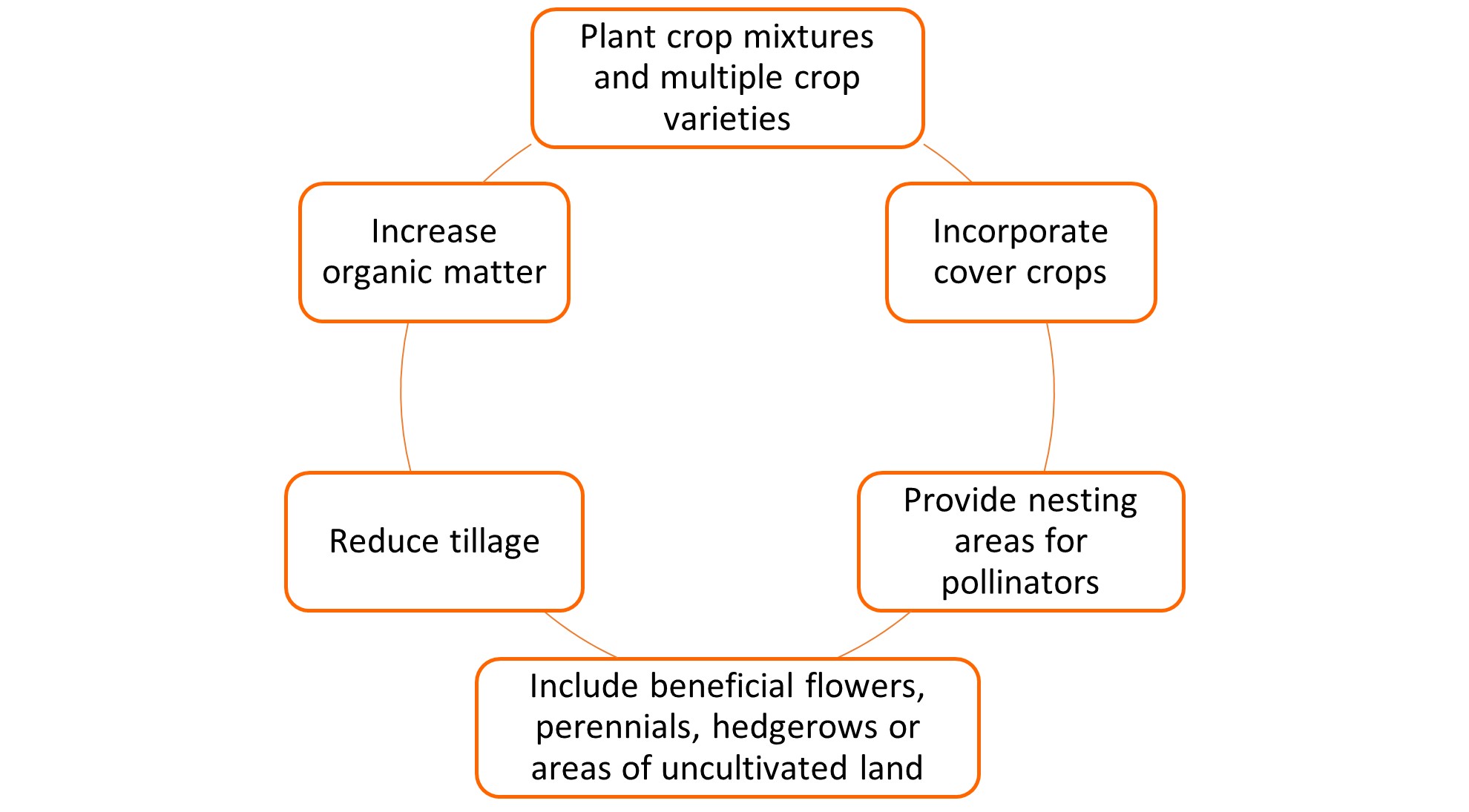2.3 Biodiversity enhancement
| Site: | TOPPlant Portal |
| Course: | Training Manual for Plant Protection in Organic Farming |
| Book: | 2.3 Biodiversity enhancement |
| Printed by: | Guest user |
| Date: | Wednesday, 3 December 2025, 8:43 AM |
Biodiversity enhancement
Learning Outcomes:
- Define what biodiversity encompasses.
- Explain the benefits of improving biodiversity.
- Describe the strategies for increasing biodiversity in organic farming.
The role of biodiversity
Biodiversity plays a crucial role in food security, nutrition, and livelihood and in the provision of ecosystem services. Biological diversity encompasses all species of plants, animals, and microorganisms and the ecosystems and ecological processes of which they are parts. In a common parlance, biodiversity may be defined as species richness (plants, animals, and microorganism) in a given habitat. It may be land, in freshwater or sea or as parasites or symbiosis. Biodiversity encompasses diversity of life on all levels: species diversity, genetic diversity as well as habitat and ecosystem diversity. A rich biological diversity is essential for preserving natural processes contributing to man’s ability to live, such as natural pest regulation, pollination of fruit biomass by insects, and the decomposition of organic matter. Agricultural policies are increasingly promoting ecological-oriented farming method that preserves biodiversity and conserves natural resources. In historic times, a more diverse landscape unfolded through farming from what was once an undifferentiated landscape dominated by forests. Today as well, regionally adapted and extensive forms of cultivation are essential prerequisites for a diverse species rich landscape.
A major tenet of sustainable agriculture is to mimic diversity that is commonly found in natural ecosystems but may be lost in agricultural terrain. Biodiversity refers to the variety of plants, animals and microorganisms above and below the soil that interact within an ecosystem. Plants and animals are consistently integrated into diverse landscapes. As a result, these systems are typically more stable, withstanding disturbances and recovering better than less diverse systems. Organic cropping systems promote a diverse, balanced ecosystem as a practice to enrich the soil and prevent weed, insect pest and disease problems. Crop diversity, crop rotations, intercropping, cover cropping, conservation tillage and incorporation of organic matter are all important components of farm biodiversity.
Benefits of encouraging diversity:
- • Improves soil quality
- Diverse crop rotations improve soil, increase farm biodiversity and boost crop yields. High-quality soils encourage dense populations of microorganisms, enhance natural biological control of pathogens, slow turnover of nutrients, encourage communities of beneficial insects and improve soil aeration and drainage. Crop rotations, management of crop residues, conservation tillage, incorporation of animal manures and the use of nitrogen-fixing crops can increase soil health and productivity.
- • Enhances insect, weed and disease control
- Diverse plantings often decrease insect pest populations. Specialized herbivores are more likely to find and remain on pure crop stands where food sources are concentrated. Fields containing a variety of crops are often rich in above- and below-ground beneficial organisms that naturally control pests, inhibit growth of disease organisms, boost a crop’s natural defenses and suppress some weeds. The use of crop diversity, crop rotations, scattered fields, adjacent uncultivated land and a perennial crop component are methods that can be used to reduce pest pressure.
- • Encourages beneficial organisms
- Planting crops that support natural enemies or directly inhibit insect attack helps to stabilize pest communities. Spatially and temporally diverse plantings ensure that natural enemy populations are provided continuous availability of resources. Beneficial insects, mites and nematodes can also be provided food and habitat by including areas of adjoining, uncultivated land and wild vegetation. Further, using ground covers and surface residues can enhance the abundance and efficiency of predators and parasitoids.
- • Spreads economic risk
- Increasing farm diversity offers the opportunity to increase profits while decreasing production costs. Adding new crops that fit the climate, geography and management requirements can increase profits by providing the opportunity to exploit niche markets, expand marketing opportunities and offset commodity price swings.
Strategies for increasing biodiversity
Healthy plant is less vulnerable to pest and disease infestation. Therefore, a major aim for the organic farmer is to create conditions which keep a plant healthy. The interaction between living organisms and their environment is crucial for a plant ‘s health. Plant’s health is more at risk in monocultures and on-farm diversification provide a balanced interaction between different plants and pests and predators. This is why a well-managed ecosystem can be a successful way of reducing the level of pest or disease population. Certain crop varieties have more effective mechanisms than others due to the adaptive nature to the environment and therefore have a lower infection risk.
The health condition of a plant depends to a large extent on the fertility of the soil. When nutrition and pH is well balanced, the plant becomes stronger and is therefore less vulnerable to infection. Climatic conditions, such as suitable temperatures and sufficient water supply, are further factors which are crucial for a healthy plant. If one of these conditions is not suitable, the plant can become stressed. Stress weakens the defense mechanisms of plants and makes them easy targets for pests and diseases. One of the most important points for an organic farmer is therefore to grow diverse and healthy plants. This avoids many pest and disease problems. Strategies for increasing biodiversity in organic farming are shown in Figure 2.2.

How to Increase On-Farm Biodiversity?
- Ensure diversity of plant species
Increasing within-field biodiversity can be achieved through planting crop mixtures and multiple crop varieties. The establishment of diverse plantings at field margins should also be considered. Planting strips of beneficial flowers, incorporating perennials, establishing hedgerows (a row of trees or shrubs separating fields) and leaving areas of land uncultivated are methods of increasing diversity on non-cropped land.
- Preservation of pollinators and natural enemies
To increase diversity of native pollinators, establish nest blocks and allow access to areas of soil, such as open soil, for nesting. A source of water is also essential. Branches of trees and shrubs, such as those in hedgerows, will also provide nesting sites for pollinators. The organic farmer should try to conserve natural enemies already present in the crop environment and enhance their impact. This can be achieved with the following methods:
- Minimize the application of natural pesticides (chemical pesticides anyway are not permitted in organic farming);
- Allow some pests to live in the field which will serve as food or host for natural enemies;
- Establish a diverse cropping system (e.g. mixed cropping);
- Include host plants providing food or shelter for natural enemies (e.g. flowers which adult beneficial insects feed on).
There are many possibilities to enhance floral diversity within and along the boundaries of crop fields:
Hedges - Use indigenous shrubs known to attract pest predators and parasitoids by offering nectar, pollen, alternative hosts and/or preys. Most flowering shrub species have this property. However, care should be taken to not use plant species known to be alternative hosts of pests or diseases.
Beetle banks - Strips of grass in the neighborhood of crop fields harbor different natural pest enemy groups like carabids, staphylinid beetles and spiders. In order to lower the risk of weeds and plants known as host plants of crop pests and diseases, one to three native grass species can be sown in strips of 1 to 3 m.
Flower strips - Use indigenous flowering plant species known to attract predators and parasitoids by offering nectar, pollen, alternative hosts and/or preys. Most flowering plant species have this property. However, care should be taken not to use alternative hosts of pests or diseases. Three to five native flowering plant species can be sown in well-prepared seed beds, arranged in strips of 1 to 3 m on the boundary of the crop field. After flowering, seeds can be collected to renew the strip or create new ones.
Companion plants - Natural pest enemies can also be attracted by companion plants within a crop. These companion plant species can be the same as used in the flower strips. A few (1 or 2 per 10 m2) flowering companion plants within a crop serve as a ‘service station’ for natural pest enemies.
- Crop rotation
Crop rotation refers to the sequence of crops and cover crops grown in a specific field. Rotation designs should include multiple crop families, manage short- and long-term crop fertility needs, reduce weed pressure, disrupt weed and disease cycles and optimize crop production.
- Intercropping
Two or more crops grown in close proximity can produce beneficial interactions. Intercropping can be achieved by growing crops in alternating rows (row intercropping), growing crops in larger alternating strips (strip intercropping), growing crops together with no distinct row arrangement (mixed intercropping) or by planting a second crop into a standing crop at the reproductive stage (relay intercropping). Special attention should be given to the spatial arrangement, plant density and expected maturity dates of selected crops.
- Cover crops
Cover crops are used to protect the soil from erosion during times when a field is not under production. Crops that are easy to plant, establish and control or kill should be selected. Suitable varieties provide reliable ground cover and have no negative impact on the following crop. It is important to evaluate rooting depth and crop characteristics, such as weed and disease suppression, nitrogen fixation and the attraction of pollinators and natural enemies. Planting dates and climate requirements are also important for consideration, as suitable crops vary by geography and climactic conditions.
- Conservation tillage
Conservation tillage requires minimal soil disturbance, keeping at least 30 percent of the soil covered by crop residue. After harvest, crop residues are left or cover crops are established until the next crop is planted. Several methods of conservation tillage have been established. No-till planting uses specialized equipment, disturbing only a small area where the seed or transplants are set. Strip- or zone-tillage creates a tilled seedbed 5 to 7 inches wide along the plant-rooting-zone, leaving the rest of the field undisturbed. Ridge-tillage creates permanent soil ridges on top of which crops are grown.
- Incorporation of organic matter
Increasing organic matter provides harbors for soil microbes and intensifies soil biological activity, helping to lessen the risk of disease. The breakdown of organic matter by soil microbes returns nutrients to the soil removed during crop production. Animal manures, cover crops, crop residues and organic amendments can be incorporated into the soil to increase organic matter content over time.





